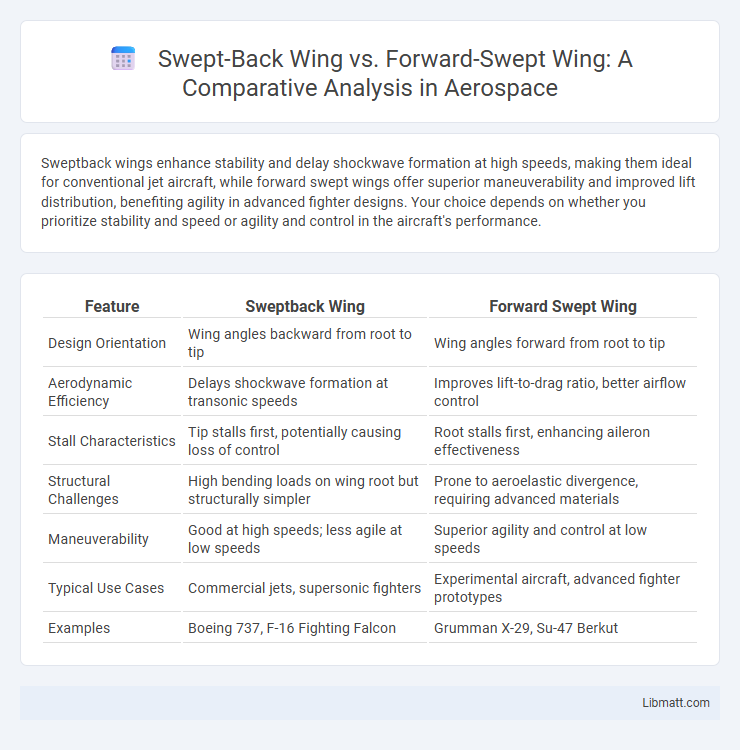Sweptback wings enhance stability and delay shockwave formation at high speeds, making them ideal for conventional jet aircraft, while forward swept wings offer superior maneuverability and improved lift distribution, benefiting agility in advanced fighter designs. Your choice depends on whether you prioritize stability and speed or agility and control in the aircraft's performance.
Table of Comparison
| Feature | Sweptback Wing | Forward Swept Wing |
|---|---|---|
| Design Orientation | Wing angles backward from root to tip | Wing angles forward from root to tip |
| Aerodynamic Efficiency | Delays shockwave formation at transonic speeds | Improves lift-to-drag ratio, better airflow control |
| Stall Characteristics | Tip stalls first, potentially causing loss of control | Root stalls first, enhancing aileron effectiveness |
| Structural Challenges | High bending loads on wing root but structurally simpler | Prone to aeroelastic divergence, requiring advanced materials |
| Maneuverability | Good at high speeds; less agile at low speeds | Superior agility and control at low speeds |
| Typical Use Cases | Commercial jets, supersonic fighters | Experimental aircraft, advanced fighter prototypes |
| Examples | Boeing 737, F-16 Fighting Falcon | Grumman X-29, Su-47 Berkut |
Introduction to Wing Sweep Configurations
Sweptback wings, characterized by their rearward angle, enhance aerodynamic efficiency by reducing drag at transonic and supersonic speeds, making them common in commercial and military aircraft. Forward swept wings, angled toward the front, offer improved maneuverability and lift at lower speeds but face structural challenges due to increased aerodynamic stress. Your choice between these wing sweep configurations depends on desired performance characteristics such as speed, stability, and maneuverability.
Fundamentals of Sweptback Wings
Sweptback wings are designed with the leading edge angled backward, improving aerodynamic efficiency by delaying shockwave formation and reducing drag at transonic speeds. This wing configuration enhances stability and control during high-speed flight by shifting the center of pressure rearward. Your aircraft benefits from improved fuel efficiency and smoother handling, particularly in commercial and military jet applications.
Key Features of Forward Swept Wings
Forward swept wings exhibit enhanced maneuverability and improved lift-to-drag ratios due to their unique aerodynamic properties. They reduce tip stall tendencies by promoting airflow inward along the wing, which enhances control at high angles of attack. Structural challenges such as increased wing bending forces are addressed through advanced composite materials to maintain wing integrity and reduce weight.
Aerodynamic Principles: Sweptback vs Forward Swept
Sweptback wings reduce drag by delaying shockwave formation at transonic speeds, enhancing stability and fuel efficiency for high-speed aircraft. Forward swept wings improve maneuverability and stall characteristics due to favorable airflow over the ailerons but face structural challenges from increased wing bending moments. Your choice between these designs depends on balancing aerodynamic efficiency with structural complexity and mission requirements.
Stability and Control Characteristics
Sweptback wings provide enhanced directional stability and delay the onset of shock waves at transonic speeds, improving overall aerodynamic efficiency. Forward swept wings offer superior maneuverability and control at high angles of attack due to favorable airflow patterns but tend to suffer from aeroelastic divergence, requiring advanced materials for structural integrity. Stability in sweptback designs is generally more predictable, while forward swept wings demand active control systems to mitigate inherent instability.
Structural Challenges and Solutions
Sweptback wings face challenges such as increased bending moments and wingtip twisting under aerodynamic loads, addressed by using advanced composite materials and wing box reinforcements to enhance stiffness and reduce weight. Forward swept wings encounter severe aeroelastic divergence due to torsional instability, which is mitigated through the implementation of highly rigid carbon fiber composites and active control systems that counteract wing twist. Both wing types require tailored structural designs to balance aerodynamic efficiency with mechanical durability, ensuring flight safety and performance.
Drag and Lift Performance Comparison
Sweptback wings reduce drag at transonic and supersonic speeds by delaying shockwave formation, enhancing lift-to-drag ratio and fuel efficiency during high-speed flight. Forward swept wings improve lift performance and stall characteristics due to more uniform airflow over the wing but tend to generate higher induced drag at lower speeds. Your aircraft's mission profile will determine whether sweptback wings' drag reduction or forward swept wings' lift advantages offer the optimal aerodynamic performance.
Notable Aircraft Examples: Sweptback and Forward Swept
The Boeing 767 and F-16 Fighting Falcon are notable examples of aircraft featuring sweptback wings, which enhance transonic performance and stability at high speeds. Forward swept wings, exemplified by the experimental Grumman X-29 and the Russian Su-47 Berkut, provide superior maneuverability and delay stall by maintaining airflow attachment at higher angles of attack. These contrasting wing designs highlight trade-offs between aerodynamic efficiency, structural complexity, and agility in modern aircraft engineering.
Applications in Modern Aviation
Sweptback wings dominate commercial and military aviation due to their effectiveness in delaying shockwaves at transonic speeds, enhancing fuel efficiency and stability. Forward swept wings find specialized use in experimental and maneuverability-focused aircraft, such as advanced fighter jets, because they improve agility and stall characteristics at high angles of attack. The Boeing X-48 and Lockheed Martin X-22 exemplify forward swept wing applications in modern research and unmanned aerial systems.
Future Trends in Wing Sweep Technology
Future trends in wing sweep technology emphasize enhanced aerodynamic efficiency and maneuverability, with sweptback wings continuing to optimize supersonic and subsonic performance by reducing drag and improving stability. Forward swept wings offer promising advancements in agility and control at high angles of attack, leveraging composite materials to address structural challenges and increase fuel efficiency. Your aircraft design considerations may benefit from integrating adaptive sweep mechanisms that combine both wing types' strengths to meet evolving performance demands.
sweptback wing vs forward swept wing Infographic

 libmatt.com
libmatt.com